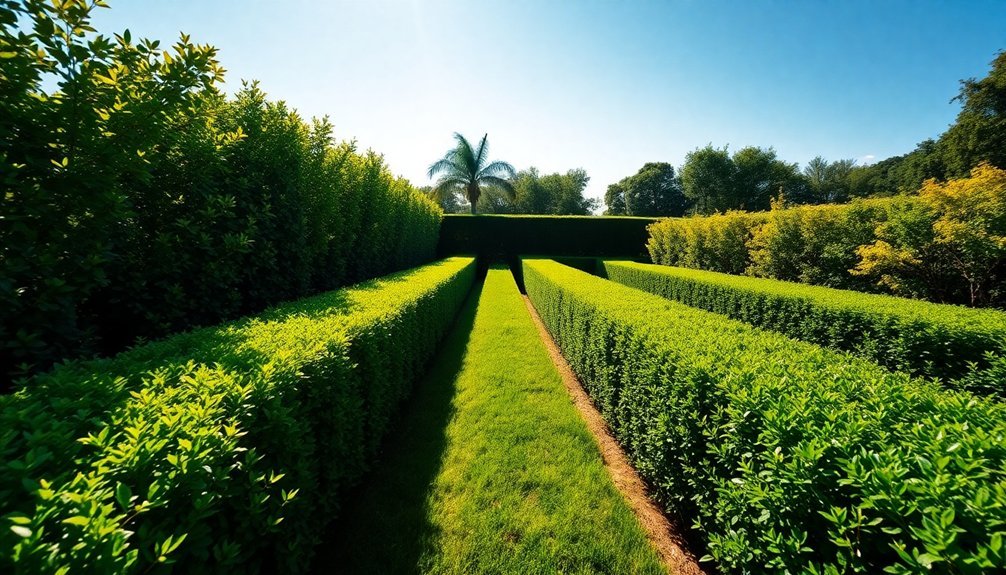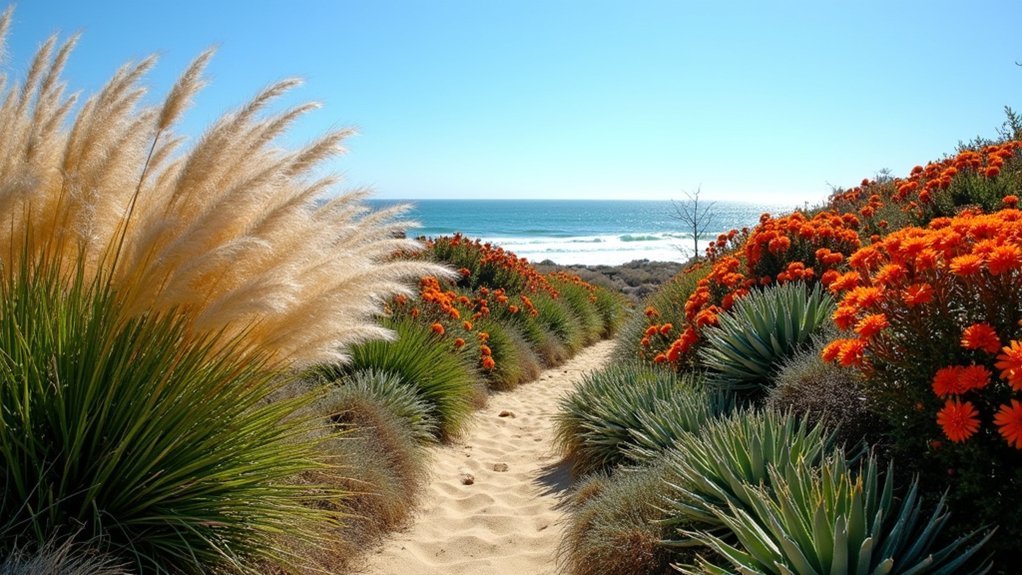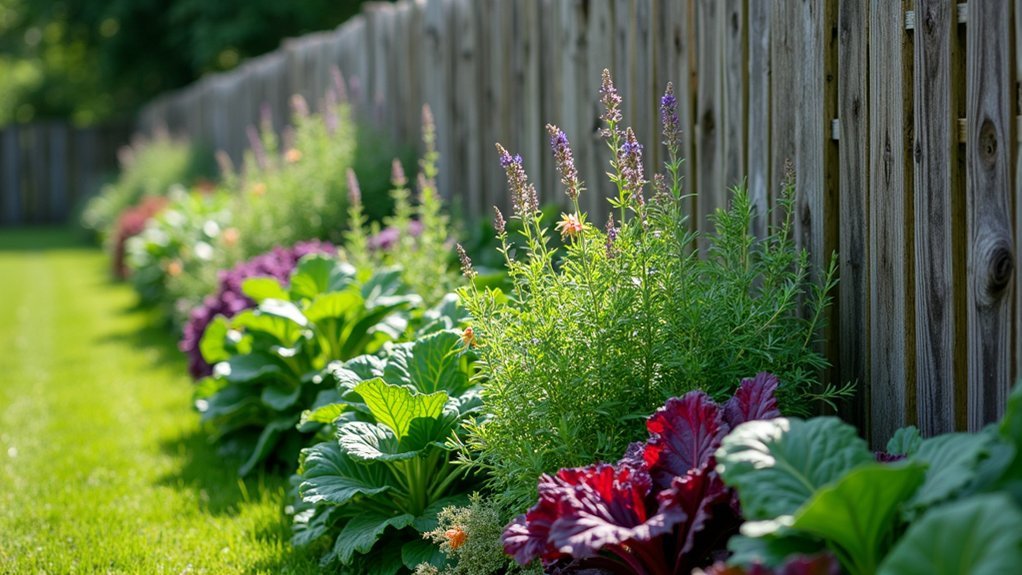Proper hedge spacing creates stronger boundaries by improving air circulation, enhancing root development, and reducing disease susceptibility. For security hedges, plant Thuja varieties 60-90cm apart to form nearly impenetrable barriers, while privacy hedges require careful density planning for year-round coverage. You'll need wider spacing for autumn planting and closer arrangements for spring growth. Wildlife-friendly hedgerows benefit from staggered planting at 25-50cm intervals. The right spacing technique transforms simple plantings into multifunctional living boundaries with lasting benefits.
The Science Behind Proper Hedge Spacing

While many gardeners focus solely on plant selection, proper hedge spacing forms the foundation of successful landscape design. The science is clear: adequate spacing allows your hedges to thrive through improved air circulation and sunlight penetration, greatly reducing disease susceptibility.
When you provide sufficient space between plants, you're enabling stronger root development and more efficient nutrient distribution throughout the soil. This prevents competition that weakens plants over time. Research has shown that tree density significantly impacts vegetative growth and productivity in various plantation systems, including hedgerows.
You'll notice the difference as your hedges develop fuller foliage and maintain structural integrity without struggling for resources.
Proper spacing also creates microclimates that support biodiversity and pollinators while providing effective protection against wind and erosion.
Security Hedges: Creating Impenetrable Barriers
You'll find that dense-planted hedges create more formidable barriers than double-row plantings, especially when security is your primary concern.
Thuja plants stand out as exceptional security options due to their tight growth pattern and ability to form nearly impenetrable living walls.
Their evergreen nature guarantees year-round protection while their rapid growth rate allows you to establish effective security barriers more quickly than with many alternative hedge species. For maximum effectiveness, consider incorporating plants like Pyracantha or Berberis which provide additional security through their thorny branches while still offering aesthetic appeal.
Dense vs. Double-Row
When security becomes a primary concern for your hedge installation, the choice between dense single-row planting and strategic double-row configurations can greatly impact effectiveness.
Double-row planting uses a staggered, zigzag pattern that creates virtually impenetrable barriers compared to single-row designs.
While double-row configurations require more garden width and initial investment, they offer superior benefits for security. The staggered layout fills gaps that would otherwise exist, improving wind resistance and sound buffering. This arrangement is especially recommended for bare root plants and enhances overall stability for your security hedge. This approach works particularly well with deciduous species like Beech and Hornbeam.
For maximum security, consider that proper density follows specific guidelines—plants should generally be spaced at half their expected 10-year width.
Some grant schemes even specify requirements, such as 6 plants per meter in double rows for countryside stewardship programs.
Thuja Plant Advantages
Among all security hedge options, Thuja varieties stand out as exceptional performers for creating truly impenetrable barriers around your property. Their evergreen nature guarantees year-round privacy while their remarkably dense foliage forms a solid visual and physical barrier.
You'll appreciate Thuja's rapid growth rate—up to 60 cm annually—allowing you to establish effective boundaries quickly. These resilient plants require minimal maintenance beyond annual trimming and demonstrate impressive resistance to pests and diseases.
Beyond security, Thuja hedges deliver environmental benefits by improving air quality, reducing noise pollution, and providing wildlife habitat. Proper spacing of 60 to 90 cm between plants prevents overcrowding and ensures each Thuja develops a strong root system.
They'll adapt to various soil conditions and climates, maintaining their elegant appearance through harsh weather. This versatility explains why Thuja hedges consistently increase property values while creating peaceful, private spaces for your mental well-being.
Privacy Hedging: Density and Height Considerations

Creating an effective privacy hedge requires careful planning of both planting density and mature height. You'll need to balance immediate coverage with long-term growth potential. Denser spacing provides faster results but costs more upfront, while wider spacing saves money but takes longer to fill in. Continuous research allows you to make timely adaptations as your hedging plants grow and conditions change.
For ideal privacy, aim for hedges at least 6 feet tall. Taller hedges require more space between plants to accommodate root development and nutrient needs.
| Plant Type | Spacing | Privacy Timeline |
|---|---|---|
| Boxwood | 12-18" | 2-3 years |
| Privet | 18-24" | 1-2 years |
| Thuja | 24-36" | 3-4 years |
| Lilac | 24-30" | 2-3 years |
| Yew | 24-36" | 3-5 years |
Consider using evergreen varieties for year-round coverage, especially if winter privacy is important for your property boundaries.
Wildlife-Friendly Spacing Techniques
When planning wildlife-friendly hedgerows, you'll need to create multi-layered habitats by spacing plants at varying heights to support diverse species.
Choose native varieties like hawthorn, blackthorn, and holly, which provide natural food sources and shelter that local wildlife have evolved alongside.
Mixing these species in a staggered formation at 25-50cm intervals will maximize biodiversity while creating dense cover that serves as both habitat and corridor for local fauna. For maximum stock-proofing and ecological benefits, consider implementing a double row hedge with plants staggered between rows spaced 35-40cm apart.
Multi-Layered Habitat Creation
The secret to a thriving space hedge row lies in its vertical complexity. By incorporating multiple layers—from decomposing mulch at ground level to a mature canopy above—you'll create a miniature ecosystem that supports diverse wildlife.
Start with a nutrient-rich soil foundation enhanced with mycorrhizal fungi and compost tea. Then build upward: add groundcover plants, followed by herbaceous perennials, shrubs, understory saplings, and finally canopy trees.
Plant these layers in clusters or "islands" to provide safe corridors for wildlife movement. This vertical structure mimics natural forest ecosystems while maximizing biodiversity in limited space. Consider replacing portions of turfgrass with native wildflowers to create diverse landscape elements that attract more insects and birds.
You'll appreciate the reduced maintenance—these dense plantings require less watering and mowing than traditional hedges. With proper spacing between your plant groupings, you're not just creating a boundary but a living habitat that benefits your landscape and local wildlife.
Native Species Selection
Native species form the backbone of any successful space hedge row, providing greater ecological benefits than non-native alternatives. When you select Black Chokeberry, Pagoda Dogwood, or American Hazelnut, you're creating resilient habitats that support local wildlife throughout the seasons. These native shrubs support birds and pollinators while creating beautiful landscape borders.
For ideal spacing, verify your hedgerow will reach at least 15 feet wide at maturity, giving birds and wildlife ample cover from predators. Layer plants of different heights to create complex habitats that maximize biodiversity. Consider incorporating species that bloom at different times to provide a continuous food source for pollinators.
Follow natural land contours when designing your hedgerow to prevent soil erosion and create a more natural appearance. This winding design increases beneficial edge habitats while enhancing the aesthetic appeal of your landscape.
Ornamental Hedgerows: Balancing Beauty and Function

Ornamental hedgerows offer a perfect blend of aesthetic appeal and practical functionality in modern landscapes. You'll enjoy their visual charm throughout the seasons while they simultaneously create wildlife habitats and serve as effective windbreaks.
When designing your ornamental hedgerow, consider incorporating a diverse mix of flowering shrubs, trees, and perennials that provide year-round interest. This multifunctional approach not only enhances your property's beauty but also supports pollinators and beneficial insects that help manage garden pests naturally.
You'll find that well-designed hedgerows reduce erosion, improve soil health, and create favorable microclimates by providing shade and retaining moisture. Properly spaced plantings create important ecotones that significantly increase overall species diversity in your landscape.
With proper maintenance and patience during the 4-8 year establishment period, your ornamental hedgerow will deliver decades of ecological benefits while defining your landscape boundaries beautifully.
Livestock-Proof Hedging for Farm Boundaries
Creating livestock-proof farm boundaries requires thoughtful selection of robust hedge plants that can withstand animal pressure while providing effective containment. Hawthorn offers excellent stock-proofing qualities with its dense growth and protective thorns.
Thoughtfully chosen hedgerows like thorny hawthorn create resilient boundaries that effectively contain livestock while enhancing farm biodiversity.
For maximum effectiveness, you'll need to space plants 8-12 inches apart and implement a dual-row system—an inner row for containment and an outer row for biodiversity. Proper spacing enables faster canopy closure, similar to how narrow-spaced crop rows create quicker shading to suppress competing plants.
Always install protective fencing at least 2 meters from your new hedge to prevent damage while it establishes.
You'll benefit beyond just containment. Well-maintained hedgerows provide shade and shelter for your livestock, reduce soil erosion, and create valuable wildlife habitats.
They're a long-term investment that increases property value while supporting sustainable farming practices. Regular rotational trimming and avoiding pesticides will guarantee your living fence thrives for decades.
Ecological Benefits of Strategically Spaced Hedges

While livestock containment remains a primary function of farm hedgerows, their ecological contributions extend far beyond simple boundaries.
When you space hedges strategically across your land, you're creating an interconnected network that maximizes environmental benefits while maintaining usable farm space.
- Living corridors connect fragmented habitats, allowing wildlife to travel safely between areas that would otherwise be inaccessible.
- Natural flood defenses slow water runoff during heavy rainfall, protecting your fields and downstream communities.
- Carbon capture zones work silently year-round, pulling CO₂ from the atmosphere and storing it in woody growth and soil.
- Microclimate regulators buffer your crops and livestock from extreme weather, reducing stress and improving yields.
Strategic spacing transforms simple hedgerows into powerful ecological assets for your land. Properly spaced hedges can significantly enhance air quality by acting as natural pollution buffers against airborne particulates from nearby roads or industrial areas.
Seasonal Factors Affecting Hedge Plant Spacing
The changing seasons dramatically influence how you should space your hedge plants to guarantee ideal growth and longevity.
During autumn planting, you'll benefit from wider spacing as roots establish before winter dormancy without competing for limited resources.
Spring plantings may require closer spacing since rapid growth follows, particularly for fast-growing species like Leylandii.
You'll need to adjust your spacing strategy based on photoperiod sensitivity—some plants respond differently to changing daylight hours throughout the year.
Don't overlook how temperature fluctuations affect spacing requirements.
In regions with extreme seasonal changes, you'll want additional space to help plants withstand stress.
For deciduous hedges, planting during dormancy with appropriate spacing prevents shock and promotes healthy development, while avoiding planting during frost or drought periods entirely.
Consider preparing a proper trench width when planting, ensuring it's twice the size of the root ball to give plants enough room for initial establishment and future growth.
Frequently Asked Questions
How Do Soil Ph Levels Affect Hedge Spacing Requirements?
Soil pH affects your hedge spacing because it influences nutrient availability and root development. You'll need wider spacing in suboptimal pH soils as plants will require more area to seek nutrients and develop properly.
Can I Mix Evergreen and Deciduous Plants in the Same Hedge Row?
Yes, you can mix evergreen and deciduous plants in the same hedge row. You'll enjoy year-round interest, greater biodiversity, and reduced pest problems. Just guarantee all plants have similar soil and light requirements.
What's the Minimum Distance Between Hedges and Building Foundations?
You'll need at least 2 feet for small shrubs, 3 feet for medium ones, and 4-5 feet for tall hedges from your foundation. These minimums prevent maintenance issues and potential structural damage from roots.
How Does Hedge Spacing Change in Coastal or Windy Areas?
In coastal or windy areas, you'll need tighter spacing—about 33cm for single rows. Consider using double rows spaced 40cm apart and staggered for better wind resistance. Choose salt-tolerant species like Hawthorn or Blackthorn.
When Is the Best Time to Transplant Established Hedge Plants?
You'll achieve the best results transplanting established hedges in fall or spring. In fall, aim for late August to September; in spring, late March to early April. These cooler periods minimize stress on your plants.
In Summary
You've now discovered that proper spacing is the foundation of any successful hedge boundary. Whether you're seeking security, privacy, or biodiversity, the gap between plants determines your outcome. Remember to take into account growth rates, seasonal changes, and your specific needs when planning. By applying these spacing principles, you'll create boundaries that aren't just barriers but living assets that enhance your property for years to come.





Leave a Reply